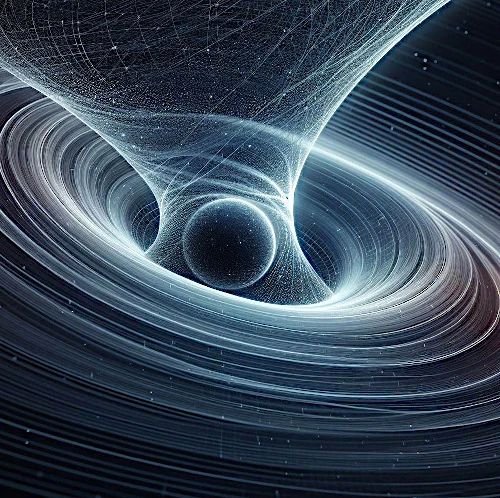
Image: The curvature of time in the curvature of space-time.
Source image astronoo.com
Albert Einstein's (1879-1955) general relativity describes gravitation as a curvature of space-time. Massive objects (stars, galaxies, galaxy clusters) bend the web of space-time around them. The more massive the object, the greater the curvature.
In the curvature of space-time, the distortion of space, in the form of curvature, is relatively easy to imagine. We understand well that a massive celestial object can follow this curvature of space while modifying it as it passes.
On the other hand, the curvature of time seems strange to us because we do not know how to image curved time. However, general relativity shows how gravitation influences the measurement of time. Time twists and expands in the presence of masses.
Atomic clocks on GPS satellites, traveling at 20,200 km altitude, must be corrected to account for this time distortion caused by Earth's gravity. This time difference is very small, but it is measurable. In other words, a clock located on the surface of the Earth runs more slowly than a clock located in space.
For what ?
The curvature of time is a more complex concept than that of space.
Our daily experience is anchored in a three-dimensional framework (length, width, and height), and imagining an additional temporal dimension is not instinctive.
Einstein's concepts of special and general relativity introduce the idea that time is an intrinsic dimension linked to space. In other words, time is measured in meters. However, our spatial intuition is based on three-dimensional phenomena, which makes it difficult to intuitively understand the fourth dimension, time.
Let's imagine space-time as a flat surface representing the universe.
When there is no significant mass or energy, this surface is flat.
But, in the presence of mass or energy, this surface curves. The curvature is more pronounced as the object is massive. The curvature of space-time is minimal in the presence of a planet, more marked in the presence of a star and reaches extreme levels in the presence of a black hole.
Now, consider time as an additional dimension, perpendicular to the three spatial dimensions we know. In curved spacetime, time follows the curvature created by the mass or energy present.
Let's imagine a moving object rolling on the x, y, z, and t axes of this curved surface (space-time).
The curvature of space-time will influence the trajectory of the object. The more pronounced the curvature, the more the object will follow a curved path.
Now let's apply this to time. As time is an additional dimension of curved space, it too follows the curvature created by mass.
If an observer moves through this curved spacetime, he or she will perceive time with a curvature. Whereas an observer in flat spacetime will perceive time as a straight line.
In other words, the curvature of spacetime affects the way time flows. The more pronounced the curvature, the slower the time will pass. This is called time dilation, where time appears to flow more slowly in regions of spacetime curved by significant mass.
This simplified analogy aims to give an intuitive picture of how the curvature of space-time affects time.
In reality, Einstein's theory of general relativity uses complex mathematical equations to describe these phenomena, but this visualization can help conceptualize the basic idea of the curvature of time.